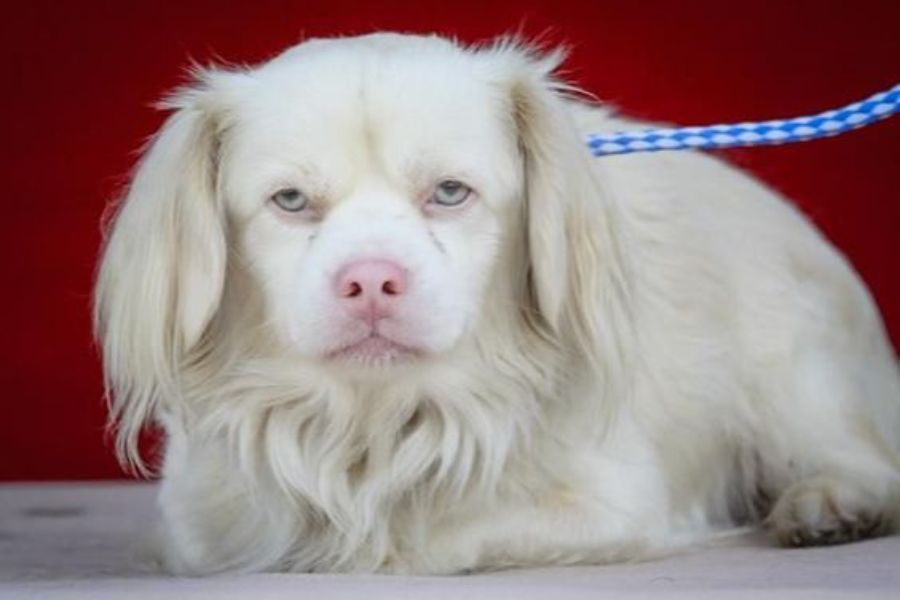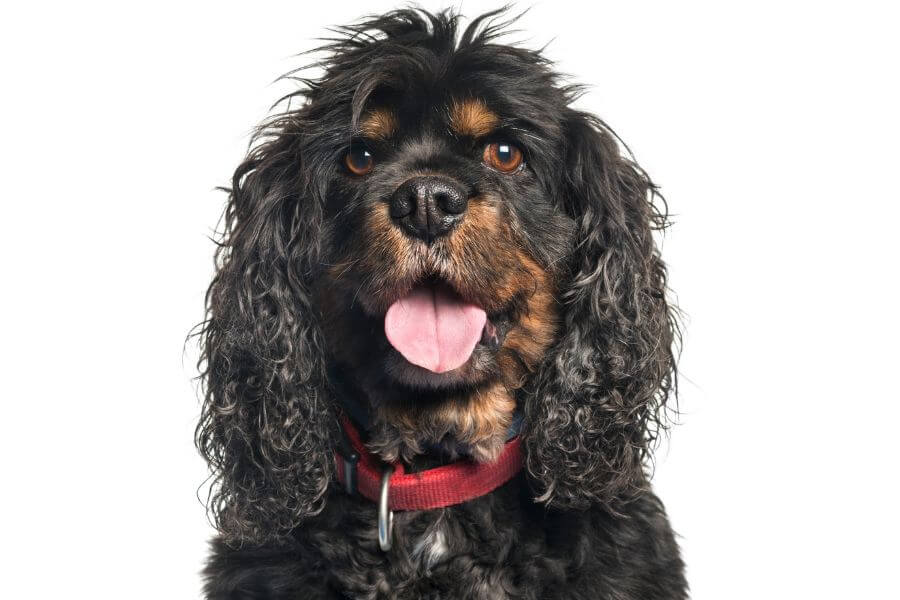King Charles Cavaliers don’t display a wide variety of colors, compared to other breeds. Their colors are solid and offer a sophisticated appearance. One that only few breeds can achieve.
Cavalier King Charles Spaniels come in 4 main colors accepted by their breed standard:
- Blenheim
- Black and tan
- Black, white, and tan (tricolored)
- Ruby
Many breeders focus on the Blenheim Cavaliers because they are the most wanted.
This article explores the four main Cavalier King Charles Spaniel Colors. You will also find interesting details about their color genetics and their connection to humans.
Cavalier King Charles Color Genetics
The color of Cavalier King Charles Spaniels is determined by melanin. This substance produces pigmentation in the hair, skin, eyes, and nose. There are two types of melanin responsible for dogs’ colors called eumelanin and phaeomelanin.
Eumelanin gives color to a Cavaliers’ hair, eyes, and nose. It is responsible for black and brown coloration.
Phaeomelanin influences only the color of the hair. This pigment is responsible for red and yellow.
In humans, freckles are reddish because they are affected by phaeomelanin.
The color of Cavaliers is also influenced by genes that[1][2]:
- Determine the location of a specific color.
- Determine which pigment is more present in a dog’s hair.
- Determine if the color is diluted or not.
This table gives details on how melanin influences the color of Cavaliers.
| Pigment | Eumelanin | Phaeomelanin | Lack of Melanin |
| What it Affects | Hair, eyes, nose | Hair | Hair, eyes, nose |
| Hair Colors | Black, brown, and variations (grey, chocolate brown, taupe, and more) | Red, yellow, and variations (all shades of red, orange, tan, gold, cream) | White |
Hair Color

In some Cavaliers, hair color is controlled either by eumelanin or phaeomelanin.
Other Cavaliers’ coat color is determined by both eumelanin and phaeomelanin. These Cavaliers display black or brown and red or yellow color variations.
Certain genes make the hair of dogs have both eumelanin and phaeomelanin, influencing the same hair follicle at the same time.
White Markings
Certain Cavaliers have wide white patches. But their base color is not white. White markings on a dog’s coat are patches where melanin is not present.
Nose Color
The nose of a cavalier King Charles Spaniel can be black, brown, or different shades of the two colors. They can’t be red or yellow because the nose color is controlled by eumelanin.
Albino Cavalier King Charles Spaniel
Albino Cavaliers are affected by a genetic mutation that affects the tyrosinase enzyme. This mutation makes them fully albino. another mutation called tyrosinase-positive causes Cavaliers to be only partially albino. The gene for the albino mutations are not specific only to dogs but also to other species.[3]
Fully albino Cavaliers are completely white. But not all pure white cavaliers are albino.
Cavaliers who suffer from Albinism lack pigmentation in their:
- Hair
- Skin
- Nose
- Eyes
- Blood vessels
There is a correlation between Albinism and congenital deafness[4, but not all albino Cavaliers are deaf.

The 4 Cavalier King Charles Spaniel Colors
Cavalier King Charles Spaniels come in different colors but not all of them fulfill the breed standard. In other words, not all are allowed in competitions. The main color combinations of Cavaliers include black, white, tan, and ruby.
The following Cavalier King Charles Spaniel colors are accepted by the AKC[5]:
- Blenheim
- Black and tan
- Black. white, and tan (tri-colored)
- Ruby
The following Cavalier King Charles Spaniel color patterns don’t fulfill the breed standard:
- Brown King Charles Cavalier
- White Cavalier King Charles Spaniel
- Black Cavalier King Charles Spaniel
- Brown and White Cavalier King Charles Spaniel
- Albino Cavalier King Charles Spaniel
The only marking color accepted by the AKC is tan.
1. Blenheim Color Cavalier King Charles Spaniel

Blenheim Cavalier King Charles Spaniels have two main colors: chestnut and white. The Blenheim color pattern is the most popular amongst Cavalier owners.
Blenheim is a color specific to Cavalier King Charles Spaniels. The name comes from a former soldier who received an estate in honor of a battle he won at Blenheim.
After he moved there, he started breeding chestnut and white King Charles Spaniels for hunting.
Chestnut is determined by phaeomelanin, while white is caused by a lack of melanin.
To be accepted by the ACK, Blenheim Cavaliers must have:
- Chestnut ears
- Chestnut eyes
- Chestnut color spread evenly on the head
- A white blaze between the ears and eyes
2. Black and Tan King Charles Spaniel

The black and tan color pattern in Cavaliers is also called “tan point”.
Their base color is black and is controlled by eumelanin. The tan markings are determined by phaeomelanin. The tan spots in a tan point pattern are present only on specific parts of a Cavalier’s body. Their location is determined by a specific gene.
Black and tan Cavaliers have tan markings on specific parts of their bodies:
- Eyes
- Chest
- Under the tail
- Legs
- Inside of the ears
The black color in a tan point pattern can be replaced by different shades of brown. This depends on what genes the Cavalier inherits from their parents.
The gene for the tan point pattern is recessive. This means both parents have to pass it on.
Black and tan King Charles Cavaliers are not as popular as Blenheim Cavaliers.
3. Tri-color Cavalier King Charles Spaniel

Black and white Cavaliers with tan markings are also called tricolor Cavaliers. Their base color is black and they have tan markings and white patches.
Tri-color Cavaliers that fulfill the breed standard have:
- Black ears
- Black around their eyes
- The color uniformly placed on the head
- A white blaze between the eyes
- Tan markings placed
The tan markings on a tri-colored Cavalier are placed:
- Over the eyes
- On the underside of the tail
- On the cheeks
- On the inner side of their ears
The tan eyebrows of this color pattern make Cavaliers more expressive.
Some tri-colored Cavaliers are mainly white while others are mainly black.
4. Ruby Cavalier King Charles Spaniel

Ruby Cavaliers can take part in competitions but they are not popular.
Breeders are not fond of breeding this type of Cavalier because they don’t have a high demand for this color.
Ruby is regulated by phaeomelanin.
Conclusion
The main Cavalier King Charles Spaniels Colors are Blenheim, ruby, black and tan, and black, white, and tan. Their colors vary depending on the genes they inherit from their parents. Some Cavaliers are not accepted in competitions because they don’t fulfill the breed standard in terms of color.
FAQs
Does the Color of a Cavalier King Charles Spaniel Influence Their Health?
The color of Cavalier King Charles Spaniels influences their health only if they are pure white, merle, or albinos. A lack of melanin is associated with deafness and blindness in dogs. Pure white or albino Cavaliers are rare and there is no evidence of merle cavaliers. As a result, the health issues related to color are not popular among Cavaliers.
What Is the Rarest Color of Cavalier King Charles Spaniels?
The rarest color of Cavalier King Charles Spaniels is black and tan. This includes only the colors accepted by the AKC as breed standards. Other colors are rarer but they are anomalies or affect crossbreds, not purebred Cavaliers.
Why Are Some Cavaliers Not Accepted in Competitions?
The main factors that include color for which Cavaliers are not allowed to take part in competitions include heavy ticking on tricolored Cavaliers and on Blenheim. Also, Ruby and black and tan Cavaliers are not allowed to have white markings.
Can Cavaliers Have Pink Noses?
Yes, Cavaliers who suffer from albinism or partial albinism can have pink noses. This is an anomaly that disqualifies Cavaliers from competitions. Most Cavaliers have black noses, except for ruby Cavaliers, who have ruby or tan noses.




